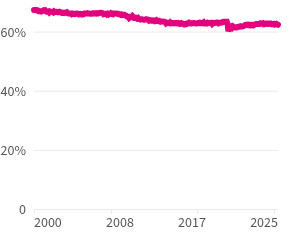What is the unemployment rate in the US right now?
Updated monthly
About 4.6% in November 2025. That's a 0.4 percentage point increase from a year before. The unemployment rate is the percentage of people in the labor force who are actively looking for work but not currently employed. It's a common way to measure the health of the job market and economy.
In November 2025,
4.6%
of the labor force was unemployed in the US
November 2025 had a
+0.4
percentage point change from November 2024
The Bureau of Labor Statistics calculates the unemployment rate through a monthly survey to identify the civilian labor force, meaning people who are employed or actively seeking work. It counts part-time workers as employed. It excludes people who aren’t actively looking for work, such as retirees or discouraged workers.
In November 2025, the unemployment rate in the US was 4.6%.
Seasonally adjusted unemployment rate, January 2007 to November 2025
The unemployment rate historically has increased during or shortly after the start of a recession. As economic activity slows, demand for goods and services decreases, leading businesses to cut costs with layoffs or hiring freezes. The unemployment rate can also change based on the number of people joining or leaving the labor force.
Labor force participation
In September 2025, the labor force participation rate was 62.4%.

Since 1948, the unemployment rate has often increased during or after recessions.
Seasonally adjusted unemployment rate, January 1948 to November 2025
The unemployment rate varies throughout the country. Based on the most recently available state-level data, South Dakota had the lowest unemployment rate in September 2025 at 2%. California had the highest unemployment rate at 5.6%.
In September 2025, the unemployment rate varied across states.
Seasonally adjusted unemployment rate
Unemployment rate, by state (September 2025)
| 1. | Washington, DC | 6.2% |
| 2. | California | 5.6% |
| 3. | Nevada | 5.3% |
| 4. | Oregon | 5.2% |
| 5. | New Jersey | 5.2% |
| 6. | Michigan | 5.1% |
| 7. | Ohio | 4.8% |
| 8. | Massachusetts | 4.7% |
| 9. | Alaska | 4.7% |
| 10. | Kentucky | 4.7% |
Keep exploring
Methodology
USAFacts standardizes data, in areas such as time and demographics, to make it easier to understand and compare.
The analysis was generated with the help of AI and reviewed by USAFacts for accuracy.
Page sources
USAFacts endeavors to share the most up-to-date information available. We sourced the data on this page directly from government agencies; however, the intervals at which agencies publish updated data vary.
